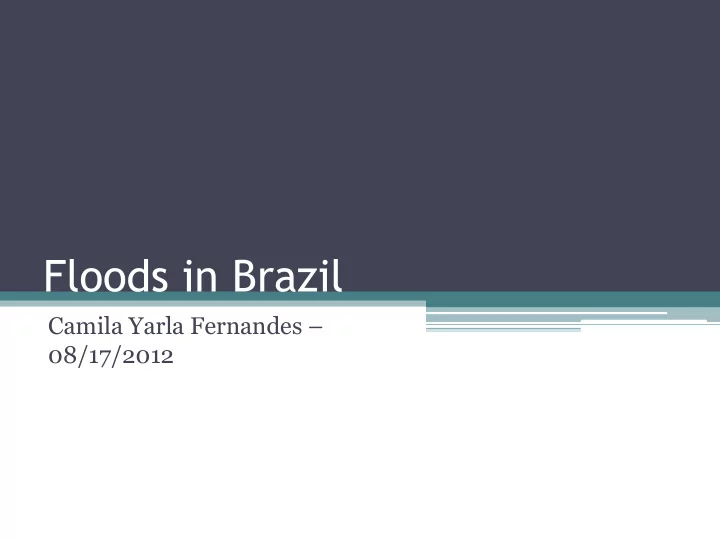

Floods in Brazil Camila Yarla Fernandes – 08/17/2012
Introduction • Floods are known to cause large damages [social, economical and environmetal.] • Objective: describe the causes for the major floods is Brazil in order to try to reduce the harms in future events.
Introduction • South America is located over different latitudes, subjected to different atmospheric systems. Consequence: diversity of climates. • Different precipitation patterns over the continent and also over Brazil. • Wet season: Summer ▫ Dec - Mar • Dry season: Winter ▫ May - Aug
Genereal view Precipitation mean for summer (left) and winter (right) from 2000-2011
Regions of Analysis • Regions subjected to different atmospheric systems present different precipitation patterns North No th during the year. Northea theast st • Regions affected mainly by ▫ Intertropical Convergence Zone (ITCZ) ▫ South Atlantic Convergence Zone (SACZ) ▫ South Atlantic Subtropical Anticyclone Midwest est ▫ Frontal Systems and Sea breeze (along the Southeas utheast coast) ▫ Mesoscale Convection Complexes (MCCs) ▫ Trade Winds South uth ▫ Cyclonic Vortices at High Levels (CVHL) ▫ Low Level Jets (LLJ)
Data • Flood Events from: ▫ DFO • Stations from: ▫ O.N.S. ▫ INMET ▫ ANA • Analysis made during the 1979-2010 period • Considered an event if higher than the DFO event and the 0.99 percentile Stations considered in the study • 383 events determined
Extreme Events Analysed Season Date Region Station Source 03/feb/79 Southeast Irapé O.N.S. 12/mar/79 Northeast Itaparica O.N.S. 20/feb/80 Midwest Serra da Mesa O.N.S. 03/mar/80 North Tucuruí O.N.S. 17/mar/80 Midwest Poxoreo INMET 13/dec/81 Southeast Itamarati ANA 06/feb/83 Southeast Promissão O.N.S. 02/feb/85 Southeast Ilha dos Pombos O.N.S. 08/mar/87 Midwest Aragarças INMET 24/dec/89 Northeast Pedra do Cavalo O.N.S. Summer 23/jan/92 Northeast Açude Bonito ANA 10/jan/97 Southeast Três Marias O.N.S. 25/dec/97 South Triunfo INMET 18/jan/98 Southeast Laranja da Terra ANA 20/dec/01 Midwest Poxoreo INMET 23/jan/03 South Triunfo INMET 07/mar/04 Northeast Fortaleza ANA 05/jan/07 Southeast Ilha dos Pombos O.N.S. 04/jan/10 South Dona Francisca O.N.S. 05/jan/10 Southeast Funil O.N.S. 15/jun/82 South Triunfo INMET Winter 12/jul/83 South Salto Pilão O.N.S. 08/aug/84 South Foz do Chapecó O.N.S.
Results • Winter Events ▫ South region 1982 /1983: Directly related with El Nino episode 06/15/82 and 07/12/83 for SST (left) and precipitation rate (right) 1984: Cyclone from the Pacific Ocean + SASA 08/08/1984 for OLR (left) and precipitation rate (right).
Results • Summer events ▫ Midwest and North region Related with MJO negative or turning into negative Previous studies claims about the existence of this relation ITCZ and trade winds ▫ Northeast Region SST dipole between North/South in South Atlantic CVHL and ITCZ 03/12/1979, 12/24/1989, 01/23/1992 and 03/07/2004 for SST (left), OLR (middle) and precipitation rate (right)
Results ▫ South region El Nino episodes South/Northeast dipole: Floods/droughts 12/25/1997, 01/23/2003 and 01/04/2010 for SST (left) and OLR (right)
Results ▫ Southeast region El Nino episodes – winds favored->higher cloudiness->SACZ 02/06/1983, 01/18/1998 and 01/05/2010 for SST (left), OLR (middle) and precipitation rate (right) Negative SST anomalies SACZ Same features, but these are not El Nino years. 02/03/1979, 12/13/1981, 02/02/1985, 01/10/1997 and 01/05/2007 for SST (left) and for OLR (right), both for 5 days prior to the events
Conclusions • In general, the causes of the events could be grouped by region, which presented similarities. • The events had different causes depending on the season and on the region. • Most of the events, when not related with anomalies as El Nino episodes, are nothing but an intensification of usual atmospheric systems. • New question: causes for this intensification.
Thank you!
Recommend
More recommend